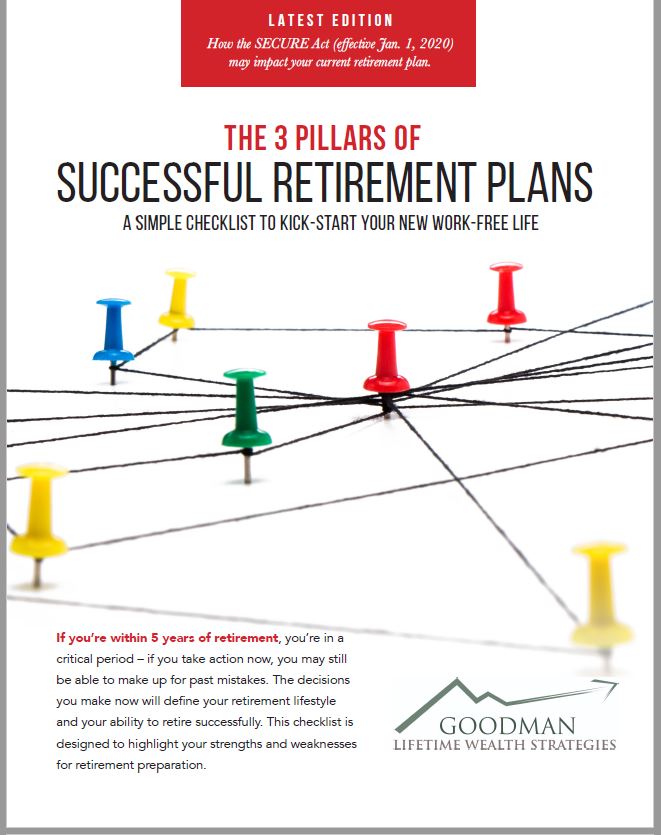A recording of our presentation “Planning Your Retirement Income in Ways That Are Best For You & Navigating Stock Market Volatility” is available for viewing on our YouTube Channel as well as some of the shorter clips from the presentation.
In this month’s recap: Stocks dropped on renewed fears of higher rates and economic weakening, coupled with some tough talk by the Fed chair.
U.S. Markets
Renewed fears of higher rates and economic weakening, coupled with a tough talk by Fed Chair Jerome Powell and other Fed officials, sent stocks lower in August.
The Dow Jones Industrial Average dropped 4.06 percent whereas the Standard & Poor’s 500 Index fell 4.24 percent. The Nasdaq Composite lost 4.64 percent.1
A Strong Start
August started off well enough, building on the summer rally over the course of the month’s first two weeks. Investor sentiment was lifted by a surprisingly strong employment report that saw the economy add 528,000 jobs in July and later by a better-than-expected Consumer Price Index (CPI) report that saw inflation decelerate slightly.2,3
Earnings Update
A fresh batch of positive earnings surprises provided an additional boost for stocks. Overall, the earnings season turned out to be better than what many investors had expected. With 97 percent of the companies comprising the S&P 500 reporting, 78 percent reported earnings that exceeded Wall Street analysts’ estimates.4
The fuel for the stock market’s rebound since the mid-June low was, in part, the belief that the Fed may ease up on the pace and magnitude of interest rate hikes owing to early signs that inflation may be cooling.
Powell’s Hammer
But Fed Chair Powell’s much-anticipated speech at the Jackson Hole Economic Symposium rattled investors. By the time Powell finished his speech on the morning of August 26th, the market was in full-on retreat. Powell’s comments did not include anything investors hadn’t already heard, but the forcefulness with which he communicated the Fed’s commitment to lowering inflation struck many investors as especially hawkish.
The market’s month-to-date gains disappeared following the speech as Powell appeared to end any investor hope of a pivot by the Fed. Stocks added to their losses in the month’s final days as investors confronted a monetary policy landscape that potentially offered little relief from further Fed interest rate hikes.
Sector Scorecard
All 11 sectors posted gains for the month, including Communications Services (+3.87 percent), Consumer Discretionary (+18.44 percent), Consumer Staples (+3.20 percent), Financials (+7.19 percent), Health Care (+3.24 percent), Industrials (+9.50 percent), Materials (+6.15 percent), Real Estate (+8.52 percent), Energy (+9.66 percent), Technology (+13.45 percent), and Utilities (+5.45 percent).2
What Investors May Be Talking About in September 2022
In the month ahead, all eyes will be on the Fed again when it meets in late September. After two consecutive 75 basis point hikes in June and July, the Federal Open Market Committee (FOMC) will once again be meeting to consider what’s next for short-term rates.
The outcome of this meeting, scheduled for September 20–21, appears more certain following Fed Chair Powell’s Jackson Hole speech. But the Fed has indicated that any potential rate hike will depend upon the economic data leading up to the meeting.
Some see the second consecutive quarter of GDP contraction and declining energy, metals, and food input costs influencing the Fed’s decision. Others believe that comments in August by Powell and other Fed officials that the inflation fight is not over may have thrown cold water on that hope.
World Markets
Weakening economies in Western Europe and China rippled through overseas markets, with the MSCI-EAFE Index falling 4.61 percent last month.6
Losses were posted across European markets, including France (-5.02 percent), Germany (-4.81 percent), and the U.K. (-1.88 percent).7
Pacific Rim markets fared better, but still ended the month mixed. Hong Kong lost 1.0 percent while Australia picked up 0.60 percent.8
Indicators
Gross Domestic Product: The economy shrank at an annualized rate of 0.6 percent in the second quarter, an improvement from the initial estimate of a 0.9 percent contraction.9
Employment: Nonfarm payrolls increased by 528,000 in July, which was double the consensus estimate. The unemployment rate dipped to 3.5 percent, while average worker wages rose 5.2 percent from a year ago.10
Retail Sales: Retail sales were flat month-over-month, but when excluding gasoline and auto sales, consumer spending rose 0.7 percent.11
Industrial Production: Industrial output increased 0.6 percent—double Wall Street estimates—as oil and gas drilling reached a seven-year high.12
Housing: Housing starts declined 9.6 percent in July, as higher costs and mortgage rates pinched new construction activity.13
Existing home sales fell 5.9 percent from the sales in June, as higher interest rates weighed on buyer affordability. It was the sixth consecutive month that existing home sales have declined. Despite the softness, the median sales price rose 10.8 percent from 12 months ago.14
New home sales dropped to their lowest level since 2016, falling 12.6 percent in July. Compared with those a year ago, sales are down by 29.6 percent.15
Consumer Price Index: Consumer prices eased in July but remained near record highs as the CPI rose 8.5 percent year-over-year.16
Durable Goods Orders: Durable goods orders were unchanged from the previous month, though were higher by 1.2 percent when excluding defense orders.17
The Fed
Fed officials agreed to a 0.75 percentage point hike in the federal funds rate, acknowledging that the economy has slowed since the Federal Open Market Committee in June.16
In a post-meeting press conference Fed Chair Powell said that future rate hikes would be made on a meeting-by-meeting basis and that it may become appropriate to slow the pace of future interest rate hikes.16
| MARKET INDEX | Y-T-D CHANGE | August 2022 |
| DJIA | -13.29% | -4.06% |
| NASDAQ | -24.47% | -4.64% |
| S&P 500 | -17.02% | -4.24% |
| BOND YIELD | Y-T-D | August 2022 |
| 10 YR TREASURY | 1.62% | 3.13% |
Sources: Yahoo Finance, August 31, 2022.
The market indexes discussed are unmanaged and generally considered representative of their respective markets. Individuals cannot directly invest in unmanaged indexes. Past performance does not guarantee future results. U.S. Treasury Notes are guaranteed by the federal government as to the timely payment of principal and interest. However, if you sell a Treasury Note prior to maturity, it may be worth more or less than the original price paid.



Leave a Reply